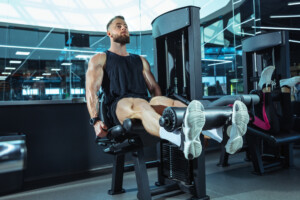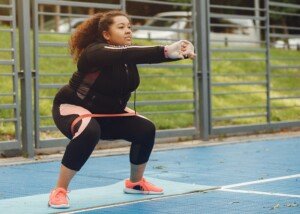You’re not too fat for ANYTHING if you can do it, including jump rope for exercise.
Just about anything, of course. As a fitness expert, I wouldn’t recommend that an obese person take up skateboarding or surfing, but certainly, you can stop thinking that you’re “too fat” to jump rope.
If you can do it, then just do it. The dangers of jumping rope are minimal; it’s not in the same league as box jumping, or inline skating, where if a very heavy person falls — injuries can result, possibly serious.
Jumping for Seconds Counts As Exercise
If you can jump rope for only 20 or even 10 seconds before you must rest, then you’ve succeeded…no matter how “fat” you think you are.

It’s a myth that in order for this under-rated activity to count as exercise, you must do it for 15 minutes nonstop, like a boxer might do.
Jump Rope Instructions for Overweight Men and Women
Try one revolution and stop.
• Did you complete it, clear the rope with your feet? Great.
• Now do two in an row.
• Now three.
• Now count 10 in a row.
• Take rests as needed.
Make sure the rope is the right length. If it’s too short, it will be more difficult to clear it with each jump.
But a long one that drags on the ground will also prove to be a nuisance.
As for the swinging, you can conserve energy by keeping your arms as close to your body as possible and having your lower forearms and wrists do most of the work.
You need not try anything fancy. Just jump — keeping your feet together or slightly apart.
Work on coordination first — being able to complete successive revolutions for 15 seconds nonstop, even if they are slow.
Again, do not be discouraged if you become very fatigued after only 15 seconds. After all, you are hopping up and down and also moving your arms.
You are not too fat to jump rope as a form of exercise if you can do it without any pain or feelings of knee instability.
As for getting quickly winded, this is normal and expected.
What about knee pain?
Knee pain isn’t uncommon in very overweight people. If you have knee pain, then stop.
You may want to instead do mini squats, going only a quarter or even less down (a half squat is when your thighs are parallel to the floor).
Go up and down with the squats at the same tempo as you would with jumping rope.
This will help strengthen weak tweaky knees. If your knee hurts when doing this, though, then stop.
If your knee gives you trouble going up and down stairs, and especially if it hurts just from regular walking, it’s time to see a doctor.
Water Hopping for Obese Wanna-Jumpers
Try prolonged hopping in water, but don’t rely on this as your primary form of exercise.

It would just be a transitional phase until your knee is healed enough to jump rope.
Weight Machines
You should also do leg presses and leg extensions. In fact, leg extensions especially will strengthen the surrounding tissue of the knee joint, because this is an isolation exercise.

Freepik.com/master1305
It isolates the quadriceps muscles, which attach to the kneecap (patella) via a tendon.
Thus, leg extensions will strengthen the tendon and create an overall stronger knee joint.
Modified Rope Jumping
Knee pain aside, if you’re particularly heavy or deconditioned and are still drawn to jumping rope, you can swing it and step over the rope as it comes towards you.
This isn’t jumping, but it’s kind of like a pre-jumping, where you’re priming your body for actual jumping.
You can make the stepping faster as your body acclimates.
You can also stand still and swing the rope forward, then back, forward, then back, to condition your arms for the activity.
Another option is to march in place while mimicking the swinging with your arms—minus the actual rope.
Don’t let anybody convince you that you are “too fat” to jump rope. If you can do it without joint pain (hip, knee, ankle), or any other kind of pain, you are not “too anything” to do it! Just make sure you have solid balance.
Morbidly Obese Woman Takes Baby Steps at Learning to Jump Rope
It would be unsafe for someone of this size to attempt jumping off the ground. Howver, she is “jump stepping,” which counts as exercise for anybody who is this heavy.
 Lorra Garrick is a former personal trainer certified through the American Council on Exercise. At Bally Total Fitness she trained women and men of all ages for fat loss, muscle building, fitness and improved health.
Lorra Garrick is a former personal trainer certified through the American Council on Exercise. At Bally Total Fitness she trained women and men of all ages for fat loss, muscle building, fitness and improved health.
.


























